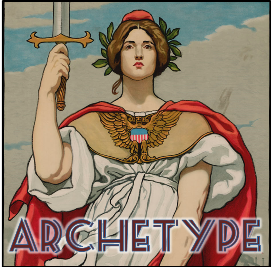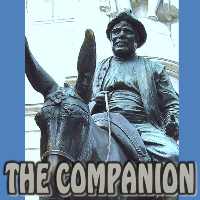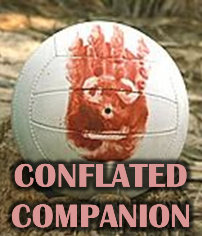 This is the sixth installment of my Writing Archetypes series, where I talk about certain roles, scenes, and plot points that can be found repeated in many stories. They synchronize stories with the narrative instincts of the human mind, and imbue them with a distinct psychological presence.
This is the sixth installment of my Writing Archetypes series, where I talk about certain roles, scenes, and plot points that can be found repeated in many stories. They synchronize stories with the narrative instincts of the human mind, and imbue them with a distinct psychological presence.
You don’t have to be a dyed-in-the-wool Jungian to recognize that archetypes are a core element in storytelling. You don’t even have to like the term “archetype.” Call them what you want: tropes, memes, patterns, threads, modes, models, Platonic forms, şurôt, whatever.
But, no matter what you call them or why they exist, they do exist, and they have undeniable storytelling power.
Before moving on to the subtler aspects of archetypal storytelling, I want to get through what I consider the Big Four characters. So far, we’ve looked at the Hero, the Rough, and the Guru. Today’s installment is the Companion.
 The Companion is often described as a Sidekick or Partner. In religious studies (which is my formal training) the Companion often called a Helper or an Ally.
The Companion is often described as a Sidekick or Partner. In religious studies (which is my formal training) the Companion often called a Helper or an Ally.
But this broad, Helper/Ally class could also include the Guru, the Rough, and more. These other “friends of the Hero” are occasionally conflated with the Companion archetype in stories with few characters, but the Companion is a distinct semantic field that deserves separate consideration.
As a role, the Companion is loosely defined as the character who has the closest relationship with the Hero. Think Achilles’s brother-in-arms Patroclus, Sherlock’s assistant Watson, Don Quixote’s squire Sancho Panza, Ferris Bueller’s best friend Cameron, Frodo’s gardener Samwise, Luke Skywalker’s droid R2-D2, and Will Turner’s true love Elizabeth Swann.
But, considering the loose meaning of “companion” today, it’s a bit of circular logic to simply say that the Companion is the character closest to the Hero. That doesn’t help us much. So, let’s take a deeper look at the dynamic of the Hero-Companion relationship, and the ancient etymology of the word “companion” itself.
_
MESS AND DRESS
The Companion is typically less active (more passive) than the Hero. The Companion only takes action to “stick by” the Hero, and to pick him up when his own active energy is waning. This is because, in order for the story to be the Hero’s story, the Hero’s action must be what counts.
Even when the Companion takes action, it’s as a surrogate for the Hero when he or she is exhausted or demoralized. Think Samwise Gamgee carrying Frodo over his shoulder on Mount Doom. As Sam himself points out, Frodo is still the Ring-bearer; Sam is merely the Ring-bearer-bearer.
Why did I choose to use the term “companion” for this archetype? Etymologically, it’s derived from the Latin for “one who takes bread with,” a messmate in the military sense. Note how linguistic scholar Tolkien contrasts Frodo’s true Companion Sam from the usurper Companion Sméagol: cursed Gollum is incapable of eating the Elvish bread offered him, and later uses crumbs to make Sam look like a bread thief, and thus a bad Companion.
The quintessential Companion in Spanish literature is Sancho Panza, and although his name means “paunch” in Spanish, it contains (and is ultimately derived from) the word for bread! Panza’s companionship with Don Quixote was particularly stressful, informing one of the book’s most celebrated quotes: “With bread all sorrows are less.” Incidentally, the poor squire says this to his own sub-Companion, the ass Dapple, and not to the unsympathetic Hero.
And note that when the Villain Barbossa offers Elizabeth Swann food—including bread!—she suspects that it’s been poisoned. You might also note that the pirate captain gives her a dress as a gift, another common symbol of Companionship that was evoked earlier in the same film when Elizabeth’s father gave her a dress as a way of encouraging a partnership with Norrington. This is the dress that cuts off her breath and causes her to fall backward into the waters of Port Royal, foreshadowing Barbossa asking for his dress back before making Elizabeth and Sparrow walk the plank.
In both cases, the partnership is wrong, and the evil dress and suspicious food drive home that message.
Elizabeth and Will’s partnership is the closest form of Companion-Hero dynamic, a romantic bond, which is traditionally sealed not only with a ring and a special dress (a wedding dress that ends up in the sea carries the relentless symbolism into the second Pirates film!) but also with the bride and groom feeding each other cake. This food-sharing aspect of the Companion archetype has its roots in human evolutionary psychology. Studies showing that sharing food carries deep meaning in primate sociology.
This isn’t just an interesting set of literary coincidences. This archetype is nestled deep in our neurons.
_
SECRET KNOWLEDGE OF THE VESSEL
In order to get this sidekick off the sidelines and into the plot, she often has a bit of illicit knowledge that injects her into the adventure. Sometimes, it’s purely incidental, as when Samwise Gamgee eavesdrops on Gandalf and Frodo discussing the impending arrival of the Ringwraiths. In other stories, the illicit knowledge is more central to the quest, as when R2-D2 is charged with taking the Death Star plans to Obi Wan or when Elizabeth Swann secretly keeps the pivotal pirate medallion she stole from Will Turner the day they met.
Moreover, secret knowledge is often related to a quasi-personal archetype I call the Vessel, which is a moving danger that carries the threat of the Villain(s) to the Hero and his allies. In Star Wars, this is clearly the Death Star, and R2’s secret knowledge is the space station’s schematics. In Lord of the Rings, Sam overhears Gandalf hastening Frodo off because the Black Riders were coming. In the first Pirates episode, the Black Pearl is the Vessel, and Elizabeth’s secret memento from the day she met Will is the key to the curse upon the Pearl‘s crew.
In Ferris Bueller’s Day Off, Cameron’s asshole dad has a car that… well, you know…
You might notice that, when dealing with trilogies, there’s a bit of a break in the Vessel archetype between episodes 1 and 2. For example, the original Death Star is blown up at the end of A New Hope, replaced by a new and improved model in The Empire Strikes Back. In episode 2, the Black Pearl‘s Vessel role is taken over by the Flying Dutchman, while Middle Earth’s Black Riders switch from horses to flying beasts.
And yes, there’s a shift from black symbolism to flying symbolism in both of those last examples. Interesting, no?
One final note: this secret knowledge of the vessel is often how the Guru brings the Hero and Companion together in the quest. In Star Wars, R2 is ostensibly Kenobi’s droid, for example. In Lord of the Rings, Gandalf’s warning about the Riders is what Samwise overhears. And, in Pirates, the Villain-Guru* Barbossa is the captain of the Vessel.
_
THE DUNKING
What else do Companion characters have in common? Think back to the weird connection between Elizabeth Swann’s dresses and taking a dip in the water. Oddly enough, many Companions tend to have their lives endangered by a good dunking.
For example, at one point in Cervantes’s classic, Sancho Panza and Don Quixote set out on the River Ebro in a boat the crazy knight commandeers because he believes it to be fated to him for some imaginary quest. As one might expect, the boat overturns during the eventual scuffle with Quixote’s foes (who turn out to be innocent millers). In this case, both the Hero and the Companion end up in the water, but Sancho is the one who by far gets the worst of it.
Compare this to R2 taking an unexpected swim on Dagobah when he tries to follow Luke, or Samwise nearly drowning trying to swim out to Frodo at the end of Fellowship of the Ring. And, as we noted earlier, Elizabeth Swann (or her wedding dress) gets dunked multiple times in Pirates.
Despite the fact that the Hero is absent from the Caribbean iterations of this Companion Dunking plot point, they all have in common the theme of the Companion’s tie to the Hero: the future Mrs. Will Turner tumbles backward away from Norrington immediately after he proposes marriage, has her dress taken from her by one false Companion before being marooned with another false Companion, and the third time it’s her wedding dress that ends up in the drink! Not coincidentally, just as she begins to doubt her commitment to Will while indulging a temporary infatuation with Sparrow.
Also, consider the scene in Ferris Bueller’s Day Off when Cameron dunks himself in the pool!
There is a similar moment, what I call the Stuck Place With Water plot point—which will be featured in a future post!—in which it’s the Hero who gets dunked. How do these highly evocative baptisms serve a story’s psychological power? To be honest, I have no idea. Does it represent the “anima” dipping into the subconscious? I’ll leave that to the Jungians to work out.
_
THE CONFLATED (INFLATED) COMPANION
As I hinted earlier, in stories with small casts the character taking up the Companion banner often has to absorb the Guru and/or Rough, expressing bits of each Helper archetype’s semantic field.
In large casts, of course, archetypes often end up divided up and doubled in multiple characters. For example, Lord of the Rings has two Roughs—Aragorn and Boromir—who each express different aspects of the archetype. We’ll really dive into this doubling in a later installment when we take a look at the intriguing Second Companion and Second Rough archetypes. But, for now let’s look at the opposite: a conflated Companion in what is essentially a two-person plot.
 It would be hard to imagine a smaller cast than the classic Tom Hanks film Cast Away. For most of the film, it’s just FedEx systems analyst Chuck Noland alone on an island or sloshing about on a raft at sea. Right?
It would be hard to imagine a smaller cast than the classic Tom Hanks film Cast Away. For most of the film, it’s just FedEx systems analyst Chuck Noland alone on an island or sloshing about on a raft at sea. Right?
Wrong! There was also Wiiiilson!
As a guy who is constantly looking for meaningful patterns—not only in literature/myth, but also in real life—I couldn’t help but see in this iconic volleyball an archetypal precursor of Gregory House‘s cleverly named sidekick Dr. Wilson, who was an obvious analog of the Sherlock Holmes Companion Dr. Watson.
Seriously, these hidden patterns run deep! You really have to keep your eyes open for them.
The name, of course, was a happy accident: Wilson is a real-world sporting goods supplier, and a volleyball washed ashore during a Cast Away screenwriter’s creative experiment in self-stranding. But, I would take a Darwinian perspective and assume that most archetypal expressions do start as random events. What determines whether these random peculiarities work is finding a niche in their environment, which is the human psyche. Call it “archetypal selection.” In the tradition of English fiction, Wilson just happens to be a distinctly evocative name for the Companion of a guy who spends the entire plot figuring things out on his own, something the writers of House later worked out more consciously and deliberately than the writers of Cast Away. **
But, let’s get back to analyzing the Companion!
Wilson plays the Guru, the Rough, and the Companion for the Hero in Cast Away. The Companion archetype only takes precedence here because its energy is the most basic: what could be more basic that simply sticking by the Hero? In Cast Away, and other minimally cast stories, the Companion should be seen as absorbing the other Allies, whose energies are then expressed through the Companion.
And the way this plays out in Cast Away is particularly intriguing, since the Companion really has no lines other than those implied by the Hero’s soliloquies. Noland’s touching conversations with this inanimate piece of sports equipment are pure storytelling genius. The volleyball encourages the stranded Hero (a Guru role) and reminds him of the dark realities of his situation (a Rough role), as well as supporting him like a Companion when he needs strength. We can overlook the inherent absurdity of casting a ball in this role because the ball is bursting with archetypal energy that makes perfect sense to our storytelling human brains.
(And, of course, because the lead actor has major chops as a thespian!)
When Wilson is lost to the capricious currents of the sea, it’s a masterful conflation of plot points: the Companion Dunking and Guru Dies and Rough Goodbye moments all wrapped up in one. The fact that this scene is so moving, despite that we’re essentially watching a weed-stuffed hunk of plastic float away, owes as much to Wilson’s powerful invocation of archetypal energies as the superb acting of Tom Hanks. The power of three Allies is being lost at once, as if Gandalf and Aragorn and Sam had all been dragged into Khazad-dûm in one fell swoop while Frodo looked on in horror.
When writing—or watching—small-cast stories, remembering to look for the markers of the Rough or Guru behind the Companion’s face can help bring the full power of the story to the fore!
* We’ll get into the shuffling of archetypes in the Pirates trilogy in a later post.
** In the same vein of happy archetypal accidents, I was also pleased that the name of my protagonist in On the Head of a Pin, private detective Charles “Chuck” Roland Oliver, neatly parallels the Cast Away protagonist Chuck Noland, even though I didn’t notice this coincidence until long after I had decided on a paladin name (Charlemagne + Roland + Olivier de Vienne) in honor of Raymond Chandler’s assertion that the hard-boiled detective is a modern-day knight errant.
